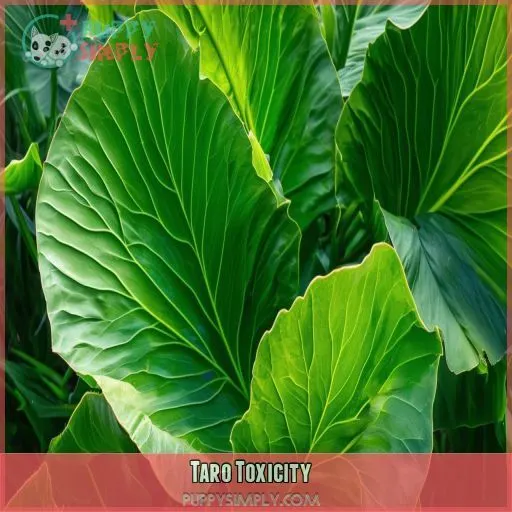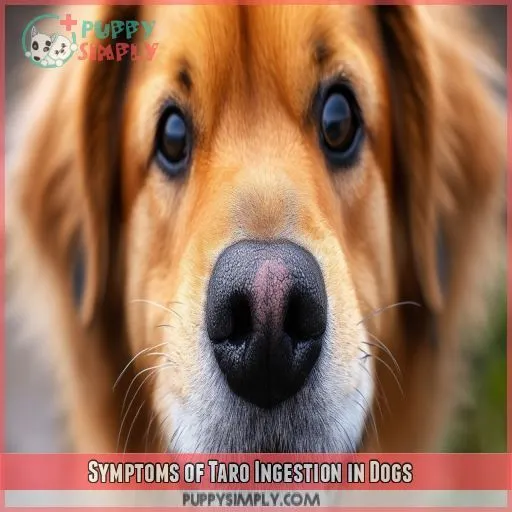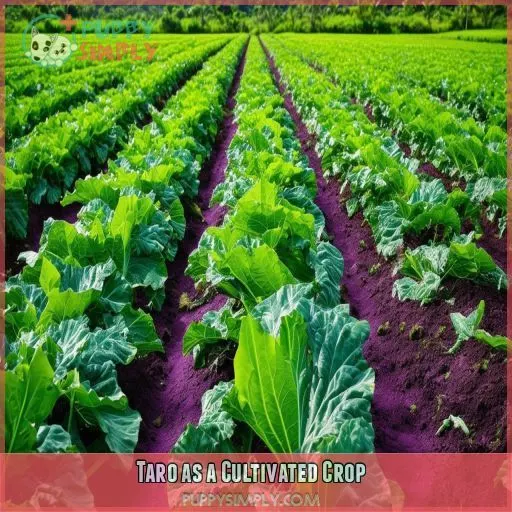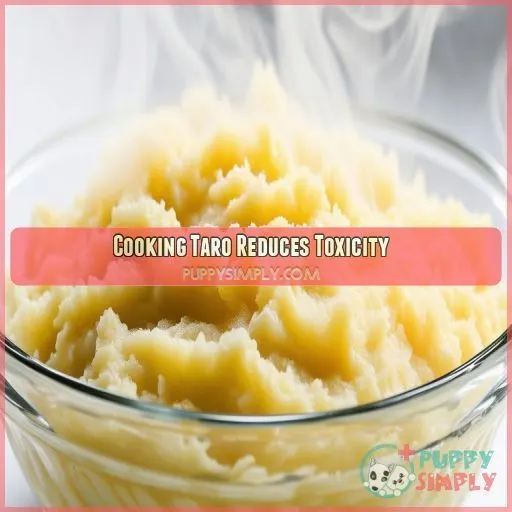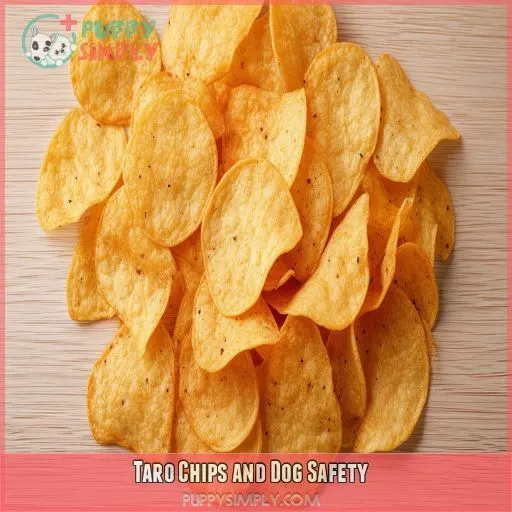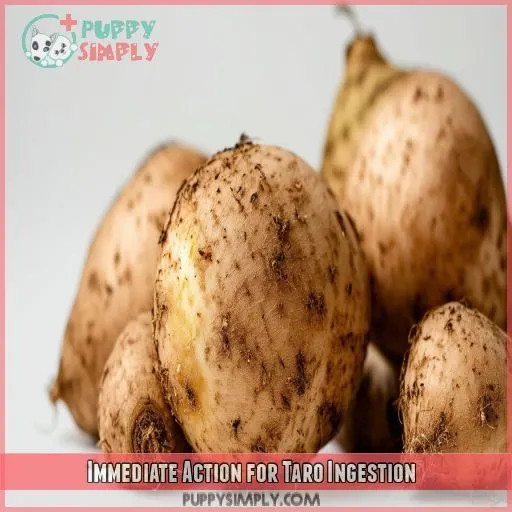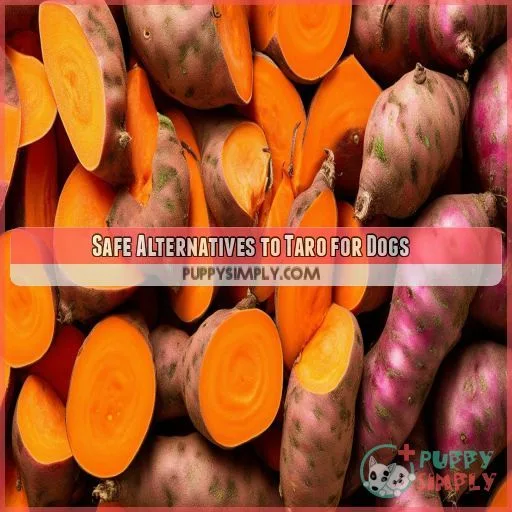This site is supported by our readers. We may earn a commission, at no cost to you, if you purchase through links.
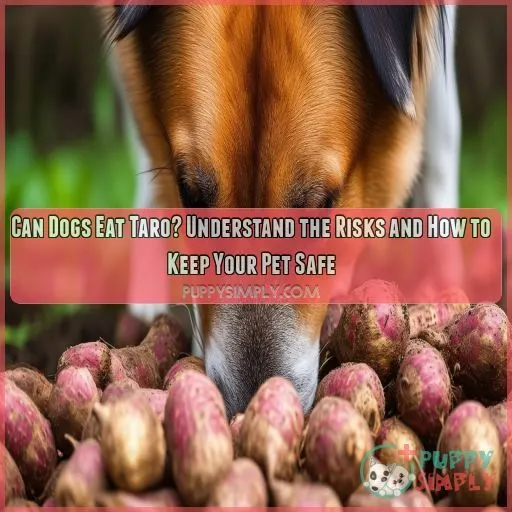
Boiling taro for 60 minutes reduces its toxicity, but it’s better to avoid giving it to your furry friend altogether.
Even processed taro chips, though safer, aren’t completely risk-free. If your dog accidentally eats taro, seek veterinary care right away.
Stick to safe alternatives like sweet potatoes or carrots for snacks.
Want to know the steps to take if your dog eats taro by mistake? Keep scrolling!
Table Of Contents
- Key Takeaways
- Can Dog Eat Taro?
- Taro Toxicity
- Symptoms of Taro Ingestion in Dogs
- Taro as a Cultivated Crop
- Cooking Taro Reduces Toxicity
- Taro Chips and Dog Safety
- Veterinary Advice on Taro for Dogs
- Immediate Action for Taro Ingestion
- Safe Alternatives to Taro for Dogs
- Frequently Asked Questions (FAQs)
- What happens if my dog eats taro?
- Is it safe to eat taro?
- Can cats eat cooked taro?
- Can dogs have taro Mochi?
- Can dogs eat taro leaves?
- Is taro beneficial for someone with Irritable bowel syndrome?
- Can dogs eat fried taro?
- What happens if a dog eats Taro?
- Can I give my dog Taro?
- What should I do if my dog eats Taro?
- Can dogs have taro in prepared dishes?
- Are there dog-safe plants similar to taro?
- Is taro toxic to other pets?
- Does taro provide any health benefits to dogs?
- Can taro cause long-term health issues in dogs?
- Conclusion
Key Takeaways
- Taro is a no-no for dogs, my friend! It’s like a landmine in their diet, waiting to wreak havoc on their mouths, tummies, and kidneys.
- Even if you cook taro, it’s still a risky business. Think of it as defusing a bomb—it’s best to just avoid it altogether.
- If your furry friend accidentally gets into some taro, don’t panic, but don’t hesitate either. Induce vomiting, give them activated charcoal, and rush them to the vet. It’s like performing a doggy Heimlich maneuver—time is of the essence!
- Instead of taro, stick to safe treats like sweet potatoes and carrots. They’re like doggy gold—nutritious and delicious, without the nasty side effects.
Can Dog Eat Taro?
No, dogs can’t eat taro. Taro contains toxic calcium oxalate crystals which can cause severe health issues like pain, vomiting, and life-threatening breathing difficulties in dogs (Source).
Taro Toxicity
Taro is toxic to dogs due to calcium oxalate crystals, which form needle-like structures called raphides. These cause severe oral irritation, leading to drooling and difficulty swallowing. If ingested, the crystals can bind with magnesium and calcium, resulting in a potentially life-threatening mineral drop.
Ingesting taro can also lead to kidney damage. Always avoid feeding taro to your dog and opt for safe alternatives like sweet potatoes or carrots. Understanding taro poisoning helps keep your pet safe.
Symptoms of Taro Ingestion in Dogs
If your dog eats raw taro, watch for symptoms like pawing at the mouth, redness, drooling, difficulty swallowing, and vomiting. It’s essential to act quickly because the situation can worsen, leading to severe breathing problems.
Pawing at Mouth Due to Pain
If your dog consumes taro, you might notice pawing at their mouth. This behavior often indicates pain and irritation in their mouth, signaling taro toxicity. Watch for:
- Drooling
- Vomiting
- Difficulty swallowing
Redness and Irritation of Gums
Redness and irritation of gums in dogs can be due to taro ingestion, leading to gums inflammation and swelling. Watch for signs like gums pain and oral diseases.
| Symptom | Sign | Action |
|---|---|---|
| Redness | Irritation | Monitor closely |
| Gums Pain | Swelling | Consult veterinarian |
| Difficulty Swallowing | Drooling | Immediate care |
Drooling
Drooling in dogs often signals mouth pain from taro ingestion. It can lead to further complications like kidney damage or life-threatening conditions. Watch for pawing at the mouth, vomiting, or other symptoms.
Difficulty Swallowing
Difficulty swallowing is a common issue from taro ingestion in dogs due to raphide damage and calcium oxalate. Look for:
- Gagging
- Choking
- Reluctance to eat
- Persistent coughing
Vomiting
Vomiting is a key symptom of taro ingestion in dogs. It can lead to dog diarrhea, abdominal pain, and crying. Immediate veterinary treatment and diagnosis are essential for recovery and preventing further complications.
Rapid Deterioration and Life-threatening Breathing Difficulties
If your dog ingests taro, rapid deterioration can occur. Watch for shortness of breath, severe cramping, and signs of kidney failure. Immediate veterinary attention is essential to prevent life-threatening complications and systemic problems.
Taro as a Cultivated Crop
Taro is a staple food and one of the oldest crops globally. The United States is the top importer, emphasizing its popularity.
Taro cultivation practices boast a short farm-to-harvest time and strong pest resistance, making it an efficient crop. This versatile plant has high nutritional value, similar to potatoes, with its taro roots, leaves, and cooked taro being nutritious.
However, the taro plant does come with challenges, especially regarding its inherent toxins that require careful preparation to guarantee safety.
Cooking Taro Reduces Toxicity
Boiling taro for 60 minutes can notably reduce its soluble oxalate levels, making it less harmful. However, undercooked taro remains risky for dogs and should be avoided entirely.
Boiling Taro for 60 Minutes Can Reduce Soluble Oxalate Levels
Boiling taro for 60 minutes effectively reduces soluble oxalate levels, making it less toxic. The extended cooking time breaks down oxalate crystals, which are the primary cause of taro’s toxicity in dogs.
This step is essential for ensuring consumption safety and mitigating risks like kidney stones, especially in breeds prone to kidney issues. While cooking can transform taro into a safer option, the residual presence of oxalates means it’s still not ideal for dog food safety.
Instead, consider safe alternatives like sweet potatoes or carrots that offer pet health benefits without the risks.
Undercooked Taro is Still Risky for Dogs
Even though boiling taro for 60 minutes reduces soluble oxalate levels, undercooked taro is still risky for dogs due to the presence of calcium oxalate crystals. These crystals can wreak havoc on your canine’s health, leading to mouth irritation, kidney failure, and even life-threatening complications.
Taro stems, raw taro, and any undercooked taro pose significant risks. Prioritize dog safety by steering clear of taro altogether. Instead, offer safe alternatives like sweet potatoes or carrots to keep your dog healthy and happy.
Taro Chips and Dog Safety
Processed taro chips have the harmful ingredient removed making them generally safe for dogs in moderation. However, always make certain they’re fully cooked to avoid any risks.
Processed Taro Chips Have the Toxic Ingredient Removed
Processed taro chips, unlike raw taro, have the calcium oxalate crystals removed during processing, making them less risky for dogs. However, your dog’s risk tolerance and any pre-existing conditions should be considered.
When processed, these chips lose most toxic elements, but the nutritional value may not outweigh potential concerns. Always think of dog safety first.
While processed taro chips may seem a convenient treat, excellent dietary alternatives like dog-friendly vegetables or specially formulated dog food and treats provide balanced dog nutrition without the risks of urinary crystals or hypocalcemia.
Taro Chips Are Generally Safe for Dogs in Moderation
Despite processed taro chips having the toxic ingredient removed, they’re generally safe for dogs if given in moderation. Just make sure the taro chips are fully cooked, as undercooked pieces can still pose a risk. If your dog enjoys crunchy snacks, taro chips can be an occasional treat, but balance is key.
Instead of making taro chips a regular part of their diet, consider healthier alternatives like sweet potatoes or carrots. Remember, regarding pet nutrition, moderation and variety are the spice of life, ensuring your furry friend’s health and happiness.
Veterinary Advice on Taro for Dogs
Veterinary advice is essential if your dog eats taro. Due to calcium oxalate crystals, which can cause severe health issues, you should take preventive measures. Dogs, especially juvenile ones, are at risk for kidney stones, which may result from taro ingestion.
Make sure to avoid root crops like taro in your dog’s diet to prevent unnecessary hardships. Remember the key tips:
- Prevent access to taro.
- Offer nutritionally safe alternatives.
- Monitor any ingestion closely.
Always consult your vet for personalized advice.
Immediate Action for Taro Ingestion
If your dog eats taro, induce vomiting promptly and administer activated charcoal to limit toxin absorption. Provide plenty of fluids, monitor kidney function, and go to the vet immediately.
Induce Vomiting
If your dog eats taro, inducing vomiting promptly can help. Use 3% hydrogen peroxide, dosed at one teaspoon per five pounds of body weight.
| Dosage Guide | Hydrogen Peroxide Method |
|---|---|
| Weight | Teaspoon Per 5 lbs |
| 10 lbs | 2 |
| 20 lbs | 4 |
| 30 lbs | 6 |
| Over 30 lbs | Consult Vet |
Administer Activated Charcoal
After inducing vomiting, administering activated charcoal can help prevent toxin absorption. Give the recommended dosage based on your vet’s advice. It’s readily available at pharmacies; store it properly, and follow all precautions. This immediate step is vital for managing your dog’s exposure to taro toxins.
Provide Fluids and Monitor Kidney Function
Keep your dog hydrated by providing fluids to counteract dehydration and electrolyte imbalance. Monitoring kidney function is necessary since calcium oxalate crystals can cause kidney damage. Make sure your dog receives supportive care to stabilize their condition and prevent further complications.
Seek Veterinary Care Immediately
If your dog eats taro, seek veterinary care immediately. This is essential to manage taro poisoning effectively. Calcium oxalate crystals can cause severe dog digestive issues and more. Follow these steps:
- Contact your vet.
- Follow their advice.
- Drive to the clinic promptly.
Safe Alternatives to Taro for Dogs
For a safer alternative to taro, you can offer your dog vegetables like sweet potatoes or carrots, which are nutritious and non-toxic. Avoid feeding your dog any plants containing calcium oxalate to prevent potential health issues.
Offer Dog-friendly Vegetables Like Sweet Potatoes or Carrots
When looking for dog-friendly vegetables, sweet potatoes and carrots are fantastic choices. Sweet potatoes are rich in fiber, vitamins A and C, and promote healthy digestion and skin.
Carrots offer a low-calorie, crunchy treat packed with beta-carotene, aiding vision and immune function. These dietary alternatives are oxalate-free treats, making sure your dog stays safe from harmful effects.
Offering a variety of veggies can keep your pet’s diet balanced and nutritious while providing a tasty, healthy option that dogs usually love. Always guarantee vegetables are cooked and cut appropriately.
Avoid Feeding Dogs Any Plants Containing Calcium Oxalate
To keep your dog safe, avoid feeding any plants containing calcium oxalate. Juvenile dogs, especially certain breeds like English and French Bulldogs, are more susceptible to kidney stones from these plants. Instead, opt for healthier, dog-friendly alternatives:
- Sweet Potatoes: Rich in vitamins and easy to digest.
- Carrots: Low-calorie and great for dental health.
- Green Beans: Crunchy, full of fiber, and dogs love them.
Choosing these alternatives reduces the risk of harmful ingestion and provides nutritious, safe treats for your canine companion. Keep an eye out for their well-being!
Frequently Asked Questions (FAQs)
What happens if my dog eats taro?
If your dog eats taro, it can experience mouth and throat swelling, drooling, vomiting, and difficulty swallowing. These symptoms may quickly worsen. Seek immediate veterinary care to avoid serious complications and guarantee your dog’s safety.
Is it safe to eat taro?
Yes, it’s safe to eat taro, but only when it’s properly cooked. Always boil it for at least 60 minutes to remove harmful calcium oxalate crystals. Avoid consuming raw taro to prevent irritation and toxicity.
Can cats eat cooked taro?
No, don’t feed cooked taro to cats. Even cooked, taro contains harmful calcium oxalate crystals that can cause severe digestive and respiratory issues. Safer treat options exist to keep your feline friend healthy and happy.
Can dogs have taro Mochi?
Dogs shouldn’t eat taro mochi. For instance, one beagle experienced coughing after eating taro chips. The calcium oxalate crystals in taro can cause severe mouth and throat irritation, making it unsafe even in cooked forms.
Can dogs eat taro leaves?
No, dogs can’t eat taro leaves. All parts of the taro plant, including the leaves, are toxic to dogs due to calcium oxalate crystals, which cause symptoms like mouth swelling, drooling, and vomiting. Seek veterinary care if ingested.
Is taro beneficial for someone with Irritable bowel syndrome?
Taro isn’t advisable for someone with Irritable Bowel Syndrome (IBS) due to its high fiber content, which might exacerbate symptoms. Opt for low-FODMAP vegetables like zucchini and carrots to manage IBS more effectively.
Can dogs eat fried taro?
Fried foods are notoriously risky for dogs. Fried taro, despite processing, can still pose health hazards. Keep your canine companion safe, steer clear of taro in any form, and stick to dog-friendly treats.
What happens if a dog eats Taro?
If your dog eats taro, they might experience mouth swelling, drooling, vomiting, and difficulty swallowing due to calcium oxalate crystals. Seek immediate veterinary care, as symptoms can quickly worsen and lead to severe health issues.
Can I give my dog Taro?
You shouldn’t give your dog taro. All parts of the taro plant are toxic to dogs, causing severe symptoms like mouth swelling and drooling. It’s best to avoid offering any form of taro to your pet.
What should I do if my dog eats Taro?
If your dog eats taro, act fast: look for mouth swelling, drooling, or vomiting. Don’t wait—seek immediate veterinary care. The situation can deteriorate rapidly, leading to serious health issues, including breathing difficulties.
Can dogs have taro in prepared dishes?
Dogs shouldn’t have taro in prepared dishes. Even when cooked, there’s a risk of undercooking, which can leave harmful calcium oxalate crystals. Stick to safer treats to guarantee your pet’s well-being and safety.
Are there dog-safe plants similar to taro?
If you’re seeking dog-safe plants similar to taro, opt for sweet potatoes. They’re rich in nutrients, non-toxic, and a delightful treat for your furry friend without the dangerous calcium oxalate crystals.
Is taro toxic to other pets?
Yes, taro is also toxic to other pets like cats and birds due to calcium oxalate crystals. Signs include mouth irritation, drooling, and difficulty swallowing. It’s best to avoid offering taro to any pets.
Does taro provide any health benefits to dogs?
In short, taro doesn’t provide health benefits for dogs. Even cooked, taro’s potential toxins and risks outweigh any nutritional value. Better options exist for treating your furry friend while ensuring their safety and well-being.
Can taro cause long-term health issues in dogs?
Yes, taro can cause long-term health issues in dogs, such as kidney stones and potential kidney failure, due to the calcium oxalate crystals. Always keep taro out of reach of your pets to safeguard their well-being.
Conclusion
Picture taro as a hidden landmine in your dog’s diet. Can dogs eat taro? Absolutely not. The risks—mouth irritation, vomiting, even kidney damage—far outweigh any benefit.
Cooking reduces toxicity but doesn’t eliminate it. Stick to safe snacks like sweet potatoes and carrots.
If your dog eats taro, act fast: induce vomiting, administer activated charcoal, and rush to the vet. Keeping taro out of your dog’s reach is the safest choice.

